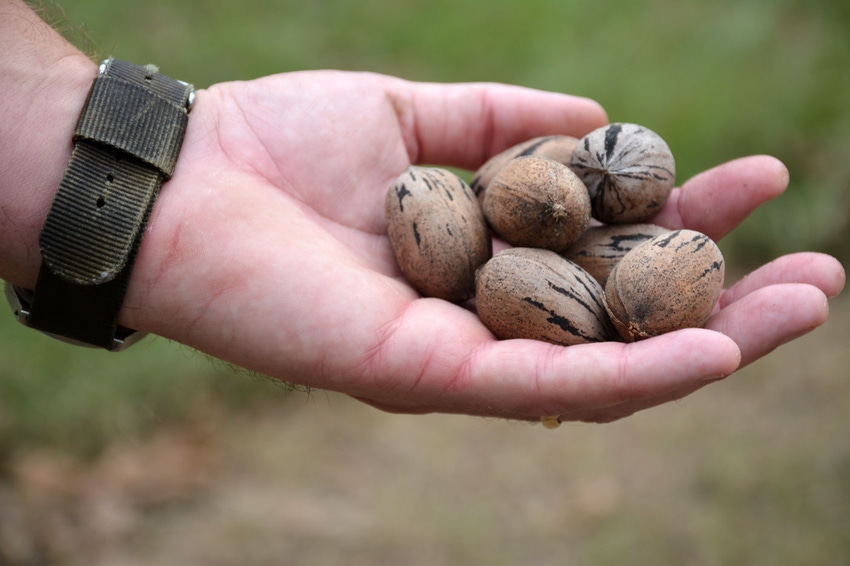
Georgia's 2020 pecan crop will be the largest in more than a decade and will set the state back on top as the country's top pecan-producing state. The crop's size and quality provide for a nice silver lining, unfortunately, overshadowed by a depressed market.
Hurricane Michael hit and knocked down hard Georgia's pecan production two years ago. Left a big mark. But Georgia growers expect the state's pecan production to rebound to about 120 million pounds in 2020. That's a strong crop any year and welcomed after two consecutive years of only 70 million pounds each, said Lenny Wells, University of Georgia Extension state pecan specialist.
Growers along with the pecan tree's natural agility worked in tandem to bring the 2020 crop back up to fighting weight, he said.
"There was a tremendous amount of cleanup involved after Michael and growers worked long and hard to get all of the damage out of orchards, and a lot of irrigation systems had to be redone along with a lot of pruning to reinvigorate those trees," he said. "But most of the recovery is due to Mother Nature. If you look at what happened in other pecan-producing states that have had major hurricanes like Georgia had two years ago, once the fruiting wood regrows the trees come back and do pretty well."
Market Pressure
"There's a lot of uncertainty in the market right now and that's for various reasons. The price is definitely lower than we've seen in a long time," he said.
Prices settled to $1.15 to $1.35 per pound around Thanksgiving for most varieties, and for certain varieties prices have fallen below $1 per pound.
Over the last two years, tariffs and on-going trade tensions with what was established export markets, such as China, haven't been friendly to U.S. pecan growers' bottom lines, he said.
"(Prices) are down now even when compared to the prices we saw prior to China’s entrance into the market. In 2009, the average in-shell price was $1.28 per pound when averaged across all varieties and harvest dates. As China entered the market the following year in 2010, in-shell pecan prices averaged $2.17 per pound, and we enjoyed similar prices until the trade tariffs went into place," he said.
Wells said buyers seem hesitant to purchase pecans right now. China buyers have been in the market at times but are price sensitive this year and as of first of December where currently out of the market.
"Tariffs and COVID are playing a role, but beyond that, our crop was early, the Chinese New Year was late, they are buying some from South Africa. U.S. pecans going to China are now going via a direct route rather than through Vietnam and other channels (as they once were). This cuts down on the shipping time. So, given all these factors, though China showed some interest, they have had time to wait and have simply been in no hurry to buy this season," he said.
Mexico Takes Chunk
Adding to the marketing problem, U.S. pecan growers now deliver a crop into a domestic market stocked with Mexican pecans.
"Mexico's now the largest producer of pecans in the world. They've overtaken the U.S. in that category and the U.S. buys over 60% of their crop, which has taken a big chunk out of the potential domestic market that U.S. growers could have, especially in the absence of that China market," he said.
Prior to China's big interest in U.S. pecans and before increased exports, U.S. growers during bumper harvests would place the crop in cold storage to wait for improved marketing opportunities later the following year. The practice isn't as economically viable in today's complex world market, he said, though some growers storing their crop for now.
"Cold storage is much more of a gamble now than it used to be not only because of the size of Mexico’s crop but also the presence of the South African crop," he said.
South Africa's crop is harvested May through July, "which shortens the window considerably for growers here to get a better price," he said, adding that South American countries like Argentina and Brazil produce more now, too.
"Holding the additional crop could also hurt prices next year, which could be disastrous if we have an off year and it creates the perfect storm of short 2021 crop volume and low price," he said.
Moving Forward
Innovate U.S. pecan representatives more than a decade ago successfully worked to expand the reach of U.S. pecans on the global stage. The efforts paid dividends to U.S. growers, he said. Equally strong initiatives now must build strong legs to bolster and carry the industry out of the current marketing challenges.
One effort started last summer. To address the issue of foreign pecans crowding the U.S. domestic market, the National Pecan Federation sent a proposal to USDA requesting a new assessment on domestic and imported pecans to establish a reinvigorated research and promotion program to “to cash in on pecans imported into the U.S., forcing them to pay their fair share of the cost of marketing pecans in the U.S.," he said. USDA is currently analyzing the proposal.
"Southeast growers should be proud of the crop they've produced this year. It's said when growers are selling for more than $2 per pound, they are selling PAH-cans, and that's a good market. But the marketing challenges are persisting and remain a challenge. We are unfortunately selling into a PEE-can market right now," Well said.
Read more about:
PecansAbout the Author(s)
You May Also Like






